Grade 10 Exam > Grade 10 Notes > Physics for Grade 10 > Physical Quantities and units
Physical Quantities and units | Physics for Grade 10 PDF Download
What is a Physical Quantity?
- Speed and velocity are examples of physical quantities; both can be measured
- All physical quantities consist of a numerical magnitude and a unit
- In physics, every letter of the alphabet (and most of the Greek alphabet) is used to represent these physical quantities
- These letters, without any context, are meaningless
- To represent a physical quantity, it must contain both a numerical value and the unit in which it was measured
- The letter v be used to represent the physical quantities of velocity, volume or voltage
- The units provide the context as to what v refers to
- If v represents velocity, the unit would be m s–1
- If v represents volume, the unit would be m3
- If v represents voltage, the unit would be V
 All physical quantities must have a numerical magnitude and a unit
All physical quantities must have a numerical magnitude and a unit
Estimating Physical Quantities
- There are important physical quantities to learn in physics
- It is useful to know these physical quantities, they are particularly useful when making estimates
- A few examples of useful quantities to memorise are given in the table below (this is by no means an exhaustive list)
Estimating Physical Quantities Table

Example: Estimate the energy required for an adult man to walk up a flight of stairs.
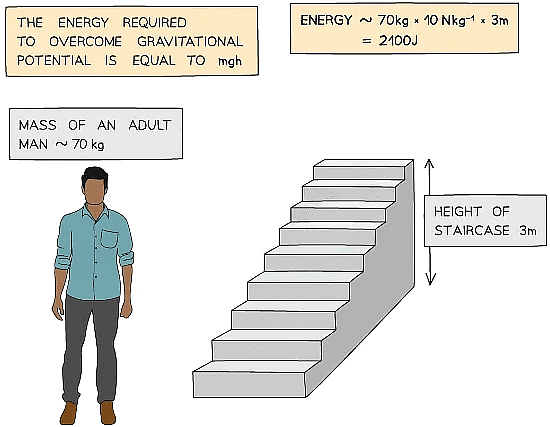
SI Units
- There is a seemingly endless number of units in Physics
- These can all be reduced to six base units from which every other unit can be derived
- These seven units are referred to as the SI Base Units; this is the only system of measurement that is officially used in almost every country around the world
SI Base Quantities Table
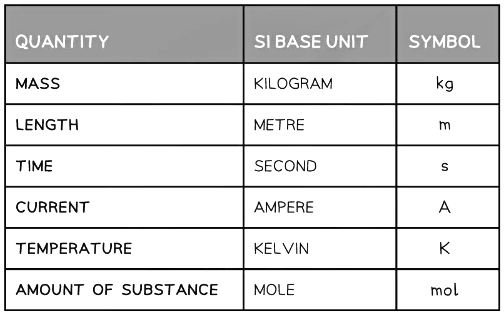
Derived Units
- Derived units are derived from the seven SI Base units
- The base units of physical quantities such as:
- Newtons, N
- Joules, J
- Pascals, Pa, can be deduced
- To deduce the base units, it is necessary to use the definition of the quantity
- The Newton (N), the unit of force, is defined by the equation:
- Force = mass × acceleration
- N = kg × m s–2 = kg m s–2
- Therefore, the Newton (N) in SI base units is kg m s–2
- The Joule (J), the unit of energy, is defined by the equation:
- Energy = ½ × mass × velocity2
- J = kg × (m s–1)2 = kg m2 s–2
- Therefore, the Joule (J) in SI base units is kg m2 s–2
- The Pascal (Pa), the unit of pressure, is defined by the equation:
- Pressure = force ÷ area
- Pa = N ÷ m2 = (kg m s–2) ÷ m2 = kg m–1 s–2
- Therefore, the Pascal (Pa) in SI base units is kg m–1 s–2
Homogeneity of Physical Equations
- An important skill is to be able to check the homogeneity of physical equations using the SI base units
- The units on either side of the equation should be the same
- To check the homogeneity of physical equations:
- Check the units on both sides of an equation
- Determine if they are equal
- If they do not match, the equation will need to be adjusted

How to check the homogeneity of physical equations
Powers of Ten
- Physical quantities can span a huge range of values
- For example, the diameter of an atom is about 10–10 m (0.0000000001 m), whereas the width of a galaxy may be about 1021 m (1000000000000000000000 m)
- This is a difference of 31 powers of ten
- Powers of ten are numbers that can be achieved by multiplying 10 times itself
- It is useful to know the prefixes for certain powers of ten
Powers of Ten Table

Scalars & Vectors
What are Scalar & Vector Quantities?
- A scalar is a quantity which only has a magnitude (size)
- A vector is a quantity which has both a magnitude and a direction
- For example, if a person goes on a hike in the woods to a location which is a couple of miles from their starting point
- As the crow flies, their displacement will only be a few miles but the distance they walked will be much longer

Displacement is a vector while distance is a scalar quantity
- Distance is a scalar quantity because it describes how an object has travelled overall, but not the direction it has travelled in
- Displacement is a vector quantity because it describes how far an object is from where it started and in what direction
- There are a number of common scalar and vector quantities
Scalars and Vectors Table

Combining Vectors
- Vectors are represented by an arrow
- The arrowhead indicates the direction of the vector
- The length of the arrow represents the magnitude
- Vectors can be combined by adding or subtracting them from each other
- There are two methods that can be used to combine vectors: the triangle method and the parallelogram method
- To combine vectors using the triangle method:
- Step 1: link the vectors head-to-tail
- Step 2: the resultant vector is formed by connecting the tail of the first vector to the head of the second vector
- To combine vectors using the parallelogram method:
- Step 1: link the vectors tail-to-tail
- Step 2: complete the resulting parallelogram
- Step 3: the resultant vector is the diagonal of the parallelogram
- When two or more vectors are added together (or one is subtracted from the other), a single vector is formed and is known as the resultant vector
Vector Addition
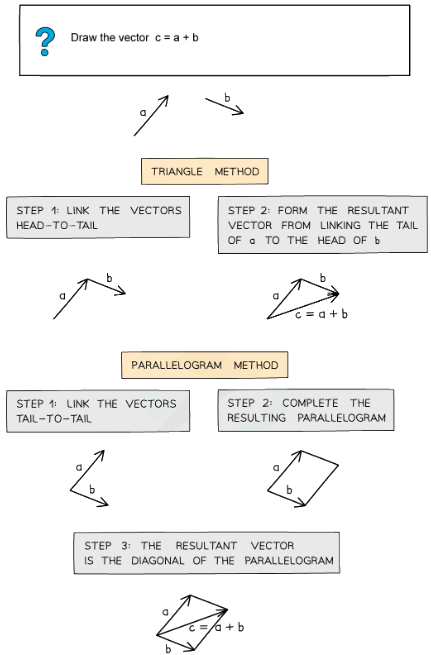
Vector Subtraction
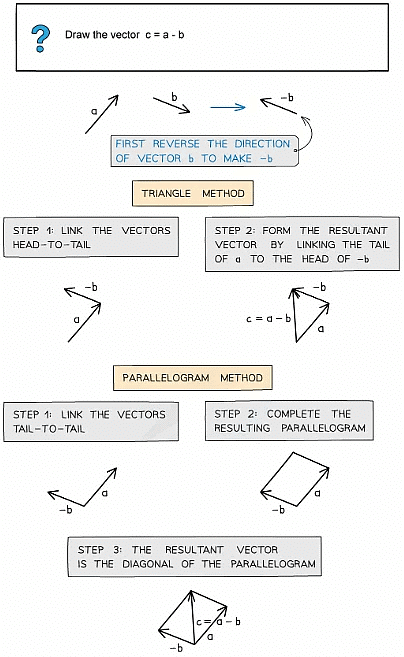
Condition for Equilibrium
- Coplanar forces can be represented by vector triangles
- In equilibrium, these are closed vector triangles. The vectors, when joined together, form a closed path

If three forces acting on an object are in equilibrium; they form a closed triangle
Resolving Vectors
- Two vectors can be represented by a single resultant vector that has the same effect
- A single resultant vector can be resolved and represented by two vectors, which in combination have the same effect as the original one
- When a single resultant vector is broken down into its parts, those parts are called components
- For example, a force vector of magnitude F and an angle of θ to the horizontal is shown below
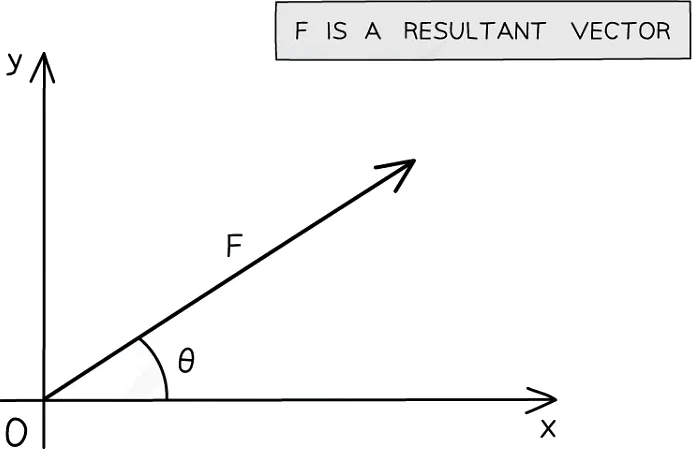
- It is possible to resolve this vector into its horizontal and vertical components using trigonometry

- For the horizontal component, Fx = Fcosθ
- For the vertical component, Fy = Fsinθ
The document Physical Quantities and units | Physics for Grade 10 is a part of the Grade 10 Course Physics for Grade 10.
All you need of Grade 10 at this link: Grade 10
|
124 videos|149 docs|37 tests
|

|
Explore Courses for Grade 10 exam
|

|
Signup for Free!
Signup to see your scores go up within 7 days! Learn & Practice with 1000+ FREE Notes, Videos & Tests.
Related Searches
















